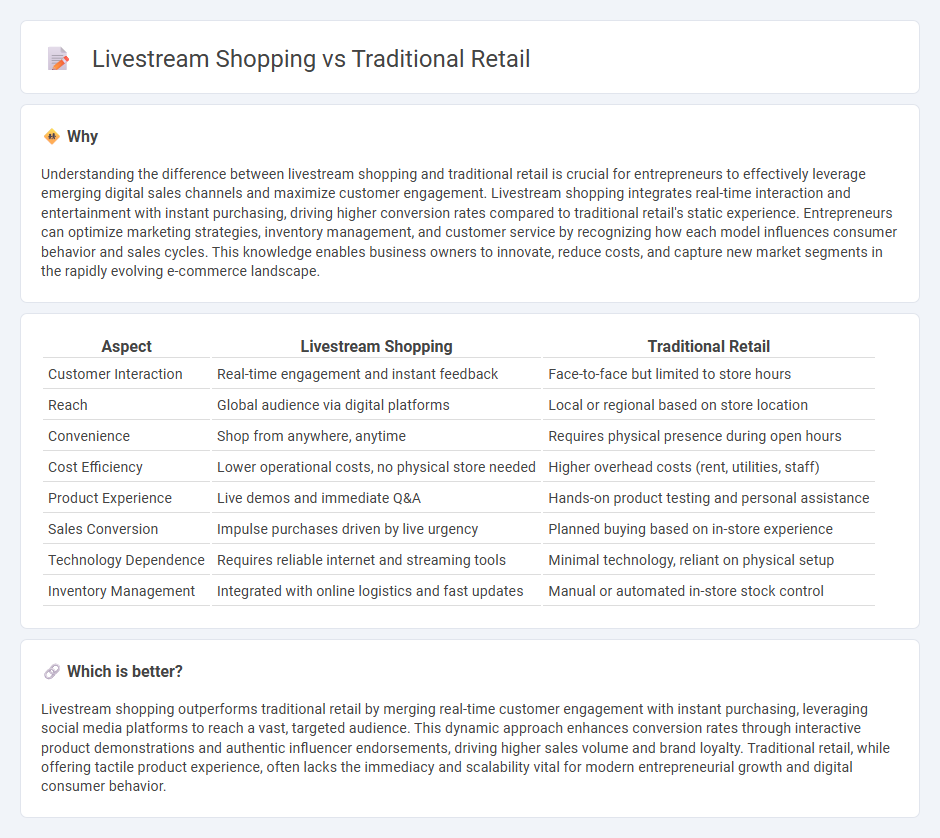
Livestream shopping leverages real-time video interactions to engage customers instantly, creating an immersive and personalized purchasing experience that traditional retail lacks. This innovative approach integrates social proof and influencer marketing, driving higher conversion rates and quicker decision-making compared to conventional store visits. Explore how livestream shopping is reshaping consumer behavior and transforming the future of retail.
Why it is important
Understanding the difference between livestream shopping and traditional retail is crucial for entrepreneurs to effectively leverage emerging digital sales channels and maximize customer engagement. Livestream shopping integrates real-time interaction and entertainment with instant purchasing, driving higher conversion rates compared to traditional retail's static experience. Entrepreneurs can optimize marketing strategies, inventory management, and customer service by recognizing how each model influences consumer behavior and sales cycles. This knowledge enables business owners to innovate, reduce costs, and capture new market segments in the rapidly evolving e-commerce landscape.
Comparison Table
| Aspect | Livestream Shopping | Traditional Retail |
|---|---|---|
| Customer Interaction | Real-time engagement and instant feedback | Face-to-face but limited to store hours |
| Reach | Global audience via digital platforms | Local or regional based on store location |
| Convenience | Shop from anywhere, anytime | Requires physical presence during open hours |
| Cost Efficiency | Lower operational costs, no physical store needed | Higher overhead costs (rent, utilities, staff) |
| Product Experience | Live demos and immediate Q&A | Hands-on product testing and personal assistance |
| Sales Conversion | Impulse purchases driven by live urgency | Planned buying based on in-store experience |
| Technology Dependence | Requires reliable internet and streaming tools | Minimal technology, reliant on physical setup |
| Inventory Management | Integrated with online logistics and fast updates | Manual or automated in-store stock control |
Which is better?
Livestream shopping outperforms traditional retail by merging real-time customer engagement with instant purchasing, leveraging social media platforms to reach a vast, targeted audience. This dynamic approach enhances conversion rates through interactive product demonstrations and authentic influencer endorsements, driving higher sales volume and brand loyalty. Traditional retail, while offering tactile product experience, often lacks the immediacy and scalability vital for modern entrepreneurial growth and digital consumer behavior.
Connection
Livestream shopping revolutionizes traditional retail by integrating real-time customer engagement with direct product demonstrations, enhancing shopping experiences and boosting sales conversion rates. Traditional retail benefits from livestream platforms by extending its reach beyond physical stores, leveraging social proof and influencer marketing to attract digitally-savvy consumers. This convergence accelerates omnichannel strategies, driving innovation and growth within the entrepreneurial retail landscape.
Key Terms
Omni-channel
Traditional retail relies heavily on physical stores and direct consumer interactions, while livestream shopping integrates real-time video engagement with e-commerce platforms to enhance customer experience. Omni-channel strategies combine in-store, online, and livestream elements, offering seamless transitions and personalized shopping journeys that boost sales and customer loyalty. Explore how leveraging omni-channel techniques can transform retail strategies for sustained growth.
Real-time engagement
Traditional retail relies on in-store experiences and physical interactions, often lacking immediate customer feedback or dynamic engagement. Livestream shopping leverages real-time video streaming technology to facilitate direct communication between brands and consumers, enhancing interactive product demonstrations and instant purchasing decisions. Explore how real-time engagement in livestream shopping transforms consumer behavior and boosts sales efficiency.
Conversion rate
Livestream shopping boasts conversion rates up to 30% higher than traditional retail due to real-time interaction and instant purchasing options. Traditional retail conversion rates average around 2-3%, while livestream events often exceed 5-8%, driven by engaging content and social proof. Explore how leveraging livestream shopping can dramatically boost your sales conversion metrics.
Source and External Links
Direct to Customer vs. Traditional Retail Business Model - Traditional retail involves selling products through intermediaries like wholesalers and retailers with physical stores and inventory management being key features, offering lower customer acquisition costs through established retail partnerships and logistics support.
Retail vs. E-commerce: What's the Difference? - Traditional retail means selling goods in physical stores, allowing direct customer interaction, immediate product availability, and minimal shipping costs, which can improve customer experience and reduce returns.
The Fall of Traditional Retail Commerce - Traditional retail evolved from mom-and-pop shops to department stores, shopping malls, and big-box stores like Walmart, which became cultural and shopping centers but have faced decline due to e-commerce and digital innovation.
 dowidth.com
dowidth.com